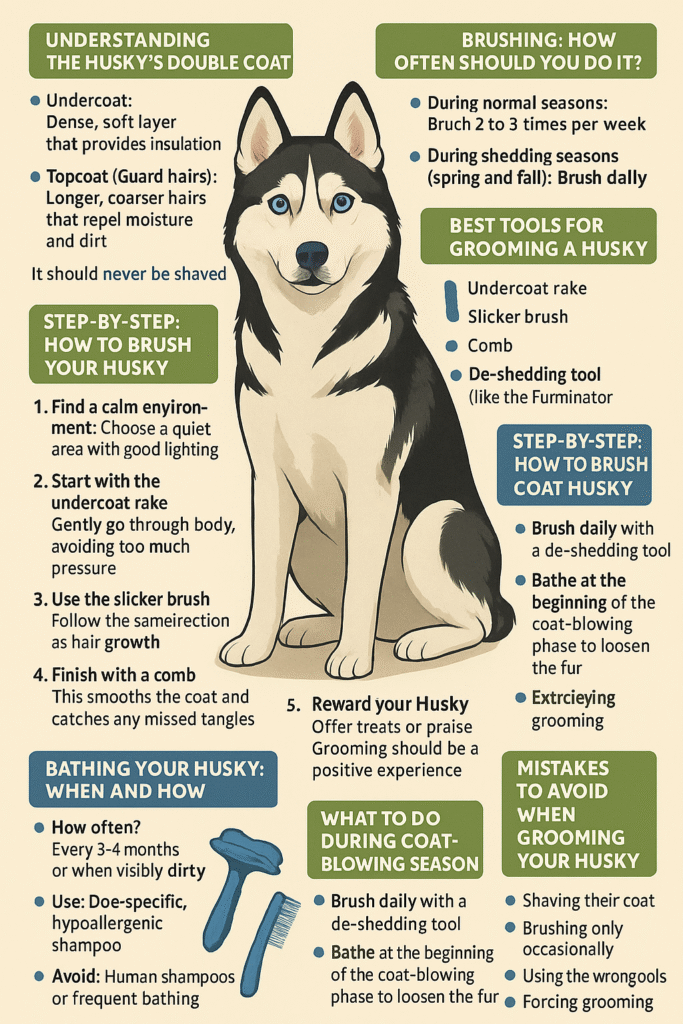The Siberian Husky’s majestic double coat is one of its most iconic features. But that beautiful fur comes with a commitment. Proper grooming is not just about appearance — it’s essential for your Husky’s health, comfort, and well-being. In this article, we’ll walk you through how to care for your Husky’s coat, the tools you’ll need, brushing techniques, and common mistakes to avoid.
Understanding the Husky’s Double Coat
Huskies have a double coat composed of:
- Undercoat: A dense, soft layer that provides insulation.
- Topcoat (Guard hairs): Longer, coarser hairs that repel moisture and dirt.
This double layer protects them from extreme cold and also helps regulate their temperature in warmer conditions. It should never be shaved — doing so can damage their natural insulation and expose their skin to sunburn and overheating.
Why Regular Grooming Matters
Proper grooming serves several key purposes:
- Prevents painful matting and tangles
- Reduces shedding and fur accumulation in your home
- Supports skin health by spreading natural oils
- Helps you check for skin issues, ticks, or parasites
- Strengthens your bond with your dog
Neglecting coat care can lead to discomfort, skin infections, and heavy fur loss.
Brushing: How Often Should You Do It?
- During normal seasons: Brush 2 to 3 times per week
- During shedding seasons (spring and fall): Brush daily
Siberian Huskies “blow” their undercoat twice a year — a process where they shed large amounts of fur in preparation for seasonal temperature changes.
Best Tools for Grooming a Husky
Having the right tools makes all the difference:
- Undercoat rake: Essential for reaching and removing dead fur in the undercoat
- Slicker brush: Great for detangling and removing loose topcoat fur
- Comb: Useful for fine grooming and reaching tricky spots
- De-shedding tool (like the Furminator): Powerful during coat-blowing season, but use carefully to avoid over-stripping
Avoid using regular human brushes or scissors — they can damage the coat or hurt your Husky.
Step-by-Step: How to Brush Your Husky
- Find a calm environment: Choose a quiet area with good lighting.
- Start with the undercoat rake: Gently go through the body, avoiding too much pressure. Focus on the neck, chest, and back legs where matting is common.
- Use the slicker brush: Follow the same direction as hair growth. Be gentle around sensitive areas like the belly and armpits.
- Finish with a comb: This smooths the coat and catches any missed tangles.
- Reward your Husky: Offer treats or praise. Grooming should be a positive experience.
Each session may take 20–40 minutes depending on the thickness of the coat and the season.
Bathing Your Husky: When and How
Huskies are naturally clean dogs and don’t have a strong odor. Bathing too often can strip their skin of natural oils.
- How often? Every 3–4 months or when visibly dirty
- Use: Dog-specific, hypoallergenic shampoo
- Avoid: Human shampoos or frequent bathing
Before bathing, brush thoroughly to remove loose fur. Afterward, towel dry and, if needed, use a low-heat blow dryer (never high heat).
What to Do During Coat-Blowing Season
Twice a year, Huskies lose huge chunks of undercoat. Here’s how to manage it:
- Brush daily with a de-shedding tool
- Bathe at the beginning of the coat-blowing phase to loosen the fur
- Expect fur everywhere — use lint rollers and vacuum frequently
- Keep your Husky cool and hydrated
Be patient — this is natural and can last 2–4 weeks.

Mistakes to Avoid When Grooming Your Husky
- Shaving their coat: It does not help with heat and may damage their natural insulation.
- Brushing only occasionally: Waiting too long allows mats to form.
- Using the wrong tools: Not all brushes are safe or effective for double coats.
- Bathing too frequently: Over-bathing can irritate the skin and cause flaking or itching.
- Forcing grooming: This creates fear and resistance — use treats and praise to make it enjoyable.
Signs of Coat and Skin Problems
Stay alert to unusual signs like:
- Bald spots or patchy fur loss
- Red or inflamed skin under the coat
- Bad odor that doesn’t go away after bathing
- Persistent itching or biting
These may indicate allergies, infections, or parasites and should be checked by a vet.
A Beautiful Coat Starts With a Healthy Dog
Grooming isn’t the only factor in coat health. Your Husky’s diet plays a role too:
- Feed high-quality food: Rich in omega-3 and omega-6 fatty acids
- Hydration matters: Ensure your dog always has access to fresh water
- Supplements: Ask your vet about fish oil or coat-boosting supplements if needed
A healthy diet supports a glossy, thick, and resilient coat year-round.
Regular brushing is more than a grooming task — it’s a ritual that keeps your Husky looking and feeling great. With the right tools, techniques, and consistency, you’ll manage their shedding, prevent problems, and enjoy a cleaner, happier home.